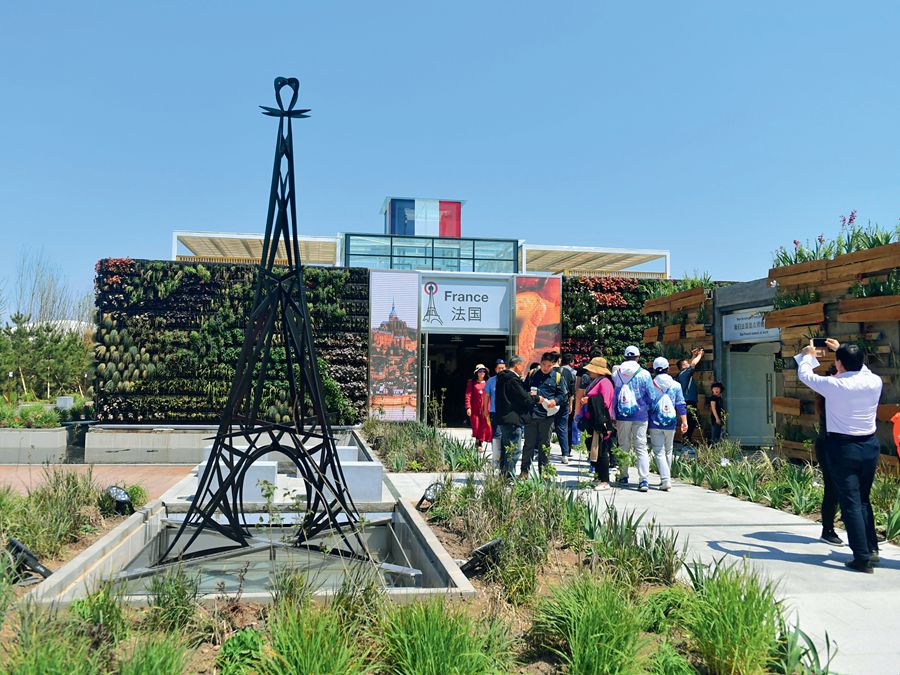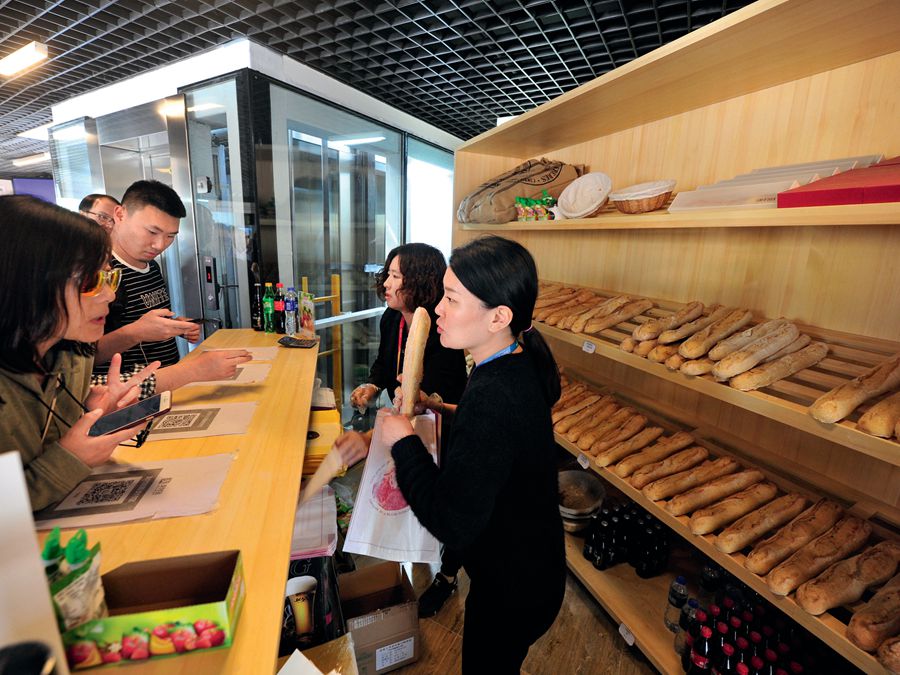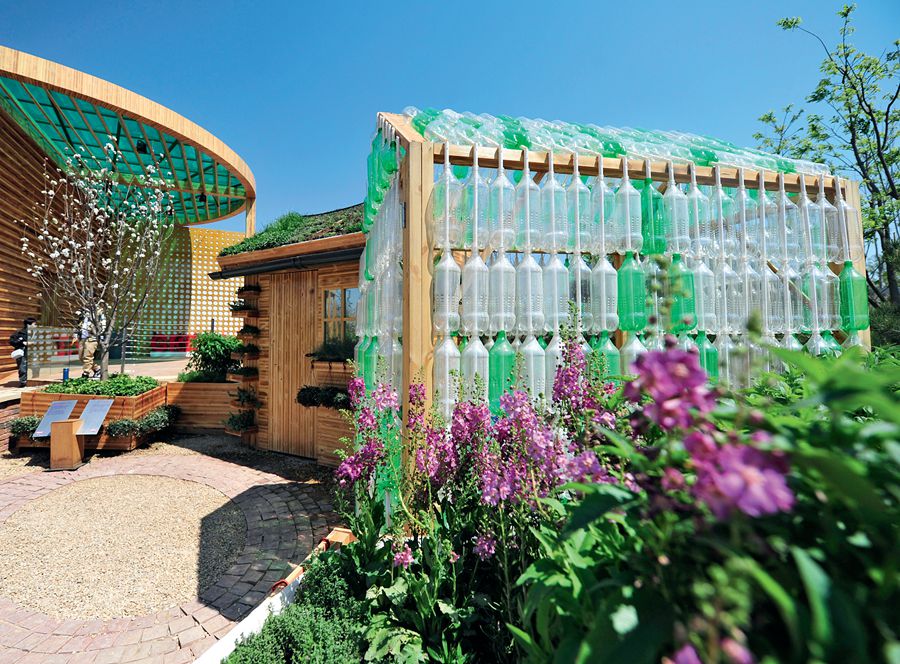THE International Horticultural Exhibition is known as the Olympics of the world’s horticultural field. The Beijing Expo 2019, which kicked off in late April, has drawn participation of around 110 countries and international organizations and more than 120 unofficial exhibitors, breaking the exhibitors’ records of previous world horticultural expositions.
“We keep making it, but the bread is sold out in a short moment. It’s so popular!” As you enter the French Pavilion, on the right hand side is a bakery, in which two bakers skillfully make bread while explaining their daily work to reporters.
On the first day of the expo on April 29, the two bakers made nearly 1,000 French Baguettes and hundreds of croissants. In this small kitchen, there are bread boards, kneaders, ovens, and bread racks, with flour and other ingredients that were all shipped from France. This small bakery makes the French Pavilion one of the most attractive ones at the Expo.
“The theme of the Expo is ‘Live Green, Live Better,’ which for ordinary people means eating better, living in more environmentally friendly buildings, commuting in a more environmentally friendly way, wearing clothes without chemical toxins, and people being healthier and the living environment being better.” Cecile Sonia Eyaan, executive commissioner of the French Pavilion and head of the Alliance France-Chine Durable et Responsable (an organization for France-China cooperation on sustainable development) commented on the theme of the Expo.
Green Life
“The theme of the International Horticultural Exhibition 2019 Beijing concerns virtually each citizen of the world,” Alain Berger, director general of the French Pavilion, praised the theme of the Expo. Berger served as the curator of the French Pavilion of the World Expo in Milan in 2015. Therefore, the French Pavilion of this year’s Beijing Expo is similar to the French Pavilion of Milan Expo 2015, which is to showcase French green agriculture through food.

The French Pavilion collects rainwater for watering flowers and vegetables, creating a small ecosystem in the garden.
On the first floor of the French Pavilion, besides organic agricultural exhibition boards, clothing made of bamboo, degradable fibers, other special materials are also displayed to help visitors better understand the French green city construction and environmentally-friendly lifestyle.
The second floor is an open-air restaurant. Eyaan said that the French Pavilion intends to use the platform of the Expo to help French enterprises further venture into the Chinese market. To this end, the French Pavilion will hold banquets monthly, cooked by renowned French chefs. A corner of the restaurant is specially divided as the vegetable and fruit nursery section. Chefs can directly take the freshest vegetables and fruits from the terrace for cooking, to convey the ecological, green, and healthy concept of life.
The exterior of the venue is a small, self-contained ecosystem, and the exterior wall is a square patch for soil wrapped in black cloth bags with various kinds of flowers. Vegetables, wheat, grain, and other crops are planted on both sides of the park. There is a cistern on the periphery to collect rainwater for irrigation of flowers and crops in the park. The whole venue embodies the concept of sustainable development and ecological protection.
Also intent on showcasing the details of green life is the British Pavilion of the Expo. The British Pavilion’s “Urban Renovation Space” demonstrates how to transform urban buildings into recreational sites full of plants, and encourages people to adopt a sustainable lifestyle, reuse, and renovate or recycle daily necessities. Sara Everett, curator and project director of the British Pavilion, said, “There are lots of links developing right now between China and the U.K. that might get even stronger in the future. A lot of the cooperation is about scientific and public institutions that are working together to support each other in promoting and protecting the environment and support the understanding of all of the plants and their importance concerning the environment.”

The bakery is a major feature of the French Pavilion.
The Japanese Pavilion of the Expo highlights a green life based on the principles and approach of Zen philosophy. Following the traditional Japanese concept of “integration of the courtyard and house,” the Japanese Pavilion blend the landscape of the courtyard and indoor scenery appropriately. People can directly enjoy the courtyard scenery through the landing window in the pavilion and return to nature.
Sustainable Urban Development
With the balloning population of modern cities, the number of buildings in cities has increased dramatically, and urban development has polluted water, air, and soil resources to a great extent. International cooperation in environmental protection is of great significance, which is why many countries and international organizations have come to the Expo this year. The Expo provides a platform for countries to exchange and communicate with each other. Learning from each other’s experiences and excellent cases of sustainable urban development will help countries to shoulder the responsibility of coping with global climate change.
Many venues of the Expo also embody the concept of sustainable development and green cities.
The International Pavilion of the Expo is quite representative. The tops of 94 “umbrellas” outside the International Pavilion are covered with photovoltaic film, which can provide auxiliary power for the night operation of the building through solar energy storage during the day. At the top of the umbrellas, a circular slope-centripetal shape is also designed. Rainwater pipes are arranged to recycle and utilize rainwater for irrigation. The International Pavilion has become a green, environmentally friendly, and low-energy-consumption building with sustainable technologies such as architectural shading, natural ventilation, evaporative cooling, drip irrigation, and rainwater recycling.

The landscape of the British Garden uses a variety of renewable resources, such as using waste plastic bottles to make environmentally friendly huts, which can store rainwater and facilitate irrigation.
The theme of the German Pavilion is “Sowing the Future.” Starting from the former Essen coal mining area in 1960, the exhibition shows the story of the gradual development and transformation of German industrial parks into the green capital of Europe. The museum also shows products made of renewable materials, including tables and chairs made of bamboo, rubber shoes made of corn, and sneakers made of mushrooms, which fully reflect the concept of sustainable urban ecological development.
The Belgian Pavilion shows the perfect integration of human living spaces and nature through terrain, plants, furniture, a “cloud” installation facility. The “cloud” installation facility is not only a work of art, but also a part of gardening, providing visitors with shelter from rain and sunshine. Meanwhile, the concepts of “recyclable” and “sustainable” persist throughout the use of materials in venues and gardens.
International Cooperation on Diversity of Species
On April 29, Chinese President Xi Jinping stressed in his speech at the opening ceremony of the Expo 2019 that building a beautiful home is the common dream of mankind. Faced with the challenges in the ecological environment, human beings are a community of a shared future, and no country can stand alone. Only with concerted efforts can we effectively deal with global environmental issues such as climate change, marine pollution and biological degradation, and achieve the United Nations 2030 Agenda for Sustainable Development goals. Only by working together can the concept of green development be deeply rooted in the hearts of the people and the journey on the road of global ecological civilization be steady and far-reaching.
In response to President Xi Jinping’s speech, Berger commented, “Chinese President Xi Jinping talked much about protecting the environment and biodiversity. Human beings should shoulder the responsibility of protecting the diversity of animal and plant species, because the diversity of species is the future of the earth, as well as the future of mankind.” China will hold the 15th Conference of the Parties to the Convention on Biological Diversity in 2020. By then, all countries around the world will expect China to shoulder the responsibility suitable for a major power and play a more active role in the field of biodiversity.
President Xi Jinping said in his speech at the opening ceremony of the Expo, “The Horticultural Expo, themed ‘Live Green, Live Better,’ is aimed at advocating the respect for and integration with the nature in people’s pursuit of a better life. I hope the green development concept embodied by the International Horticultural Exhibition 2019 Beijing should be spread to every corner of the world.”


